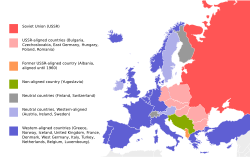Historical divisions
This section possibly contains original research .(September 2020) |
Classical antiquity and medieval origins

Prior to the Roman conquest, a large part of Western Europe had adopted the newly developed La Tène culture. As the Roman domain expanded, a cultural and linguistic division appeared between the mainly Greek-speaking eastern provinces, which had formed the highly urbanised Hellenistic civilisation, and the western territories, which in contrast largely adopted the Latin language. This cultural and linguistic division was eventually reinforced by the later political east–west division of the Roman Empire. The Western Roman Empire and the Eastern Roman Empire controlled the two divergent regions between the 3rd and the 5th centuries.
The division between these two was enhanced during late antiquity and the Middle Ages by a number of events. The Western Roman Empire collapsed, starting the Early Middle Ages. By contrast, the Eastern Roman Empire, mostly known as the Greek or Byzantine Empire, survived and even thrived for another 1000 years. The rise of the Carolingian Empire in the west, and in particular the Great Schism between Eastern Orthodoxy and Roman Catholicism, enhanced the cultural and religious distinctiveness between Eastern and Western Europe.
After the conquest of the Byzantine Empire, center of the Eastern Orthodox Church, by the Muslim Ottoman Empire in the 15th century, and the gradual fragmentation of the Holy Roman Empire (which had replaced the Carolingian Empire), the division between Roman Catholic and Protestant became more important in Europe than that with Eastern Orthodoxy.
In East Asia, Western Europe was historically known as taixi in China and taisei in Japan, which literally translates as the "Far West". The term Far West became synonymous with Western Europe in China during the Ming dynasty. The Italian Jesuit priest Matteo Ricci was one of the first writers in China to use the Far West as an Asian counterpart to the European concept of the Far East. In Ricci's writings, Ricci referred to himself as "Matteo of the Far West". [6] The term was still in use in the late 19th and early 20th centuries.
Religion
Christianity is the largest religion in Western Europe. According to a 2018 study by the Pew Research Center, 71.0% of Western Europeans identified as Christians. [7]
In 1054, the East–West Schism divided Christianity into Western Christianity and Eastern Christianity. This split Europe in two, with Western Europe primarily under the Catholic Church, and much of Eastern Europe under the Eastern Orthodox Church. Ever since the Reformation in the 16th century, Protestantism has also been a major denomination in Europe, mostly in the West.
Cold War

During the four decades of the Cold War, the definition of East and West was simplified by the existence of the Eastern Bloc. A number of historians and social scientists view the Cold War definition of Western and Eastern Europe as outdated or relegating. [8] [9] [10]
During the final stages of World War II, the future of Europe was decided between the Allies in the 1945 Yalta Conference, between the British Prime Minister, Winston Churchill, the U.S. President, Franklin D. Roosevelt, and the Premier of the Soviet Union, Joseph Stalin.
Post-war Europe was divided into two major spheres: the Western Bloc, influenced by the United States, and the Eastern Bloc, influenced by the Soviet Union. With the onset of the Cold War, Europe was divided by the Iron Curtain. This term had been used during World War II by German Propaganda Minister Joseph Goebbels and, later, Count Lutz Schwerin von Krosigk in the last days of the war; however, its use was hugely popularised by Winston Churchill, who used it in his famous "Sinews of Peace" address on 5 March 1946 at Westminster College in Fulton, Missouri:
From Stettin in the Baltic to Trieste in the Adriatic an iron curtain has descended across the Continent. Behind that line lie all the capitals of the ancient states of Central and Eastern Europe. Warsaw, Berlin, Prague, Vienna, Budapest, Belgrade, Bucharest and Sofia; all these famous cities and the populations around them lie in what I must call the Soviet sphere, and all are subject, in one form or another, not only to Soviet influence but to a very high and in some cases increasing measure of control from Moscow.
Although some countries were officially neutral, they were classified according to the nature of their political and economic systems. This division largely defines the popular perception and understanding of Western Europe and its borders with Eastern Europe on the east side. On the western side is the Atlantic ocean.
The world changed dramatically with the fall of the Iron Curtain in 1989. West Germany peacefully absorbed East Germany, in the German reunification. Comecon and the Warsaw Pact were dissolved, and in 1991, the Soviet Union ceased to exist. Several countries which had been part of the Soviet Union regained full independence.
Western European Union

In 1948 the Treaty of Brussels was signed between Belgium, France, Luxembourg, the Netherlands and the United Kingdom. It was further revisited in 1954 at the Paris Conference, when the Western European Union was established. It was declared defunct in 2011 after the Treaty of Lisbon, and the Treaty of Brussels was terminated. When the Western European Union was dissolved, it had 10 member countries. Additionally, it had 6 associate member countries, 7 associate partner countries and 5 observer countries.




